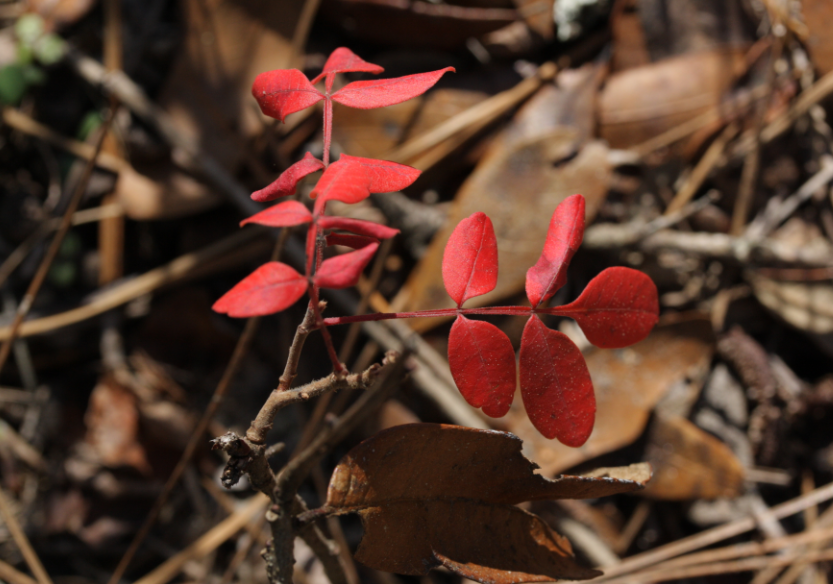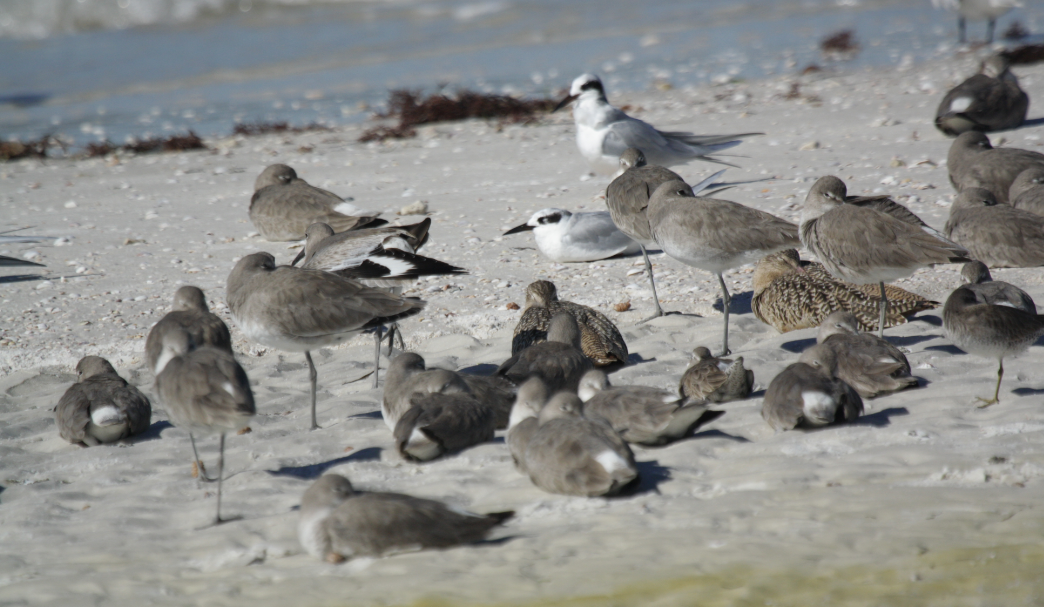Due to the success of the first bioblitz event at Tejon back in May, it was with no surprise that another event was held so soon after, this time in late August. But this was still only the second time that this sort of event had been held on the Tejon Ranch property, California's largest area of private land and superior in size to many national parks. Given that the property is an intermingling sanctuary of mountain, desert, chaparral and valley ecosystems, often in close proximity, it was a real privilege to gain any access to the land at all.
The wildlife was not particularly interested in waiting for anyone to give the go ahead for the event to begin however. In the rolling hinterlands many of us were able to observe a pronghorn frozen in place under the dry, burning sun, well before we reached base camp.
 |
Pronghorn in the Tejon valley grasslands. Despite how it may look, it was unfortunately not particularly
close. |
Additionally, a roadside stop on the drive up procured a new late-summer buckwheat for me, Eriogonum baileyi.
 |
| Eriogonum baileyi growing at the base of a chaparral hillside. |
 |
| To most perhaps not the most assuming or obvious of flowering plants, and indeed easily overlooked. |
A few bumps later, and we finally arrived at the wind-strung realm of Sacatara Canyon and pitched the tents. We had good looks at a relative to the common "stinkbug" on the desert track nearby. Though it was much later in the season, several wildflowers were still in bloom, and many new species rose up to exhibit their best.
Lessingia glandulifera was one such plant, flowering well along a small segment of the lower valley oak areas.
 |
| The Tenebrionid beetle Philothus cf. actusosus. |
 |
| A small but showy growth of Lessingia glandulifera. |
 |
| Heterotheca sessiflora, a close relative to the ubiquitous telegraphweed. |
We were then treated to a bioblitz introduction talk by Scott Pipkin and Laura before being "let loose", so to speak. Given the large quantity of events, I'll keep myself to posting a few highlights for the remainder of the post.
The first highlight I'd like to post is a new ladybug for me,
Exochomus aethiops. It comes from the notoriously difficult subfamily of Chilocorines, which often cannot be identified without the specimen, but this guy is relatively diagnostic in California fauna, if only for its complete lark of markings.
 |
| Exochomus aethiops swept from Ericameria nauseosa. |
 |
Care should be taken to separate other Exochomus, but
the high domed shape and shine rule out other species. |
A new odonate for me, and a species that had been on my wishlist for some time, was the
desert firetail,
Telebasis salva, common around stagnated ponds just below the north and eastern hillsides. Others were able to see the dragonfly equivalent of this damselfly, the cardinal meadowhawk
Sympetrum illotum, but they didn't show for me!
 |
| Desert firetail, Telebasis salva. |
Perhaps one of the greatest surprises for me were the large numbers of
Bell's sparrow in the canyon. This was a bird I had been seeking for several years without luck, not only did it surprise to see this species at all but it soon became apparent that it was easily the most common bird in the entire canyon at this time.
 |
The sparsely streaked back and dark malar separate these birds from the closely related
and once conspecific sagebrush sparrow. |
 |
One could only ask that they weren't so skittish and, at times, hard
to approach... |
The lower portions of the canyon held great numbers of two more buckwheats I had not recorded before,
Eriogonum wrightii and
Eriogonum rosea.
Eriogonum wrightii was a larger shrub with bigger flowers:
Yet despite its size it was still an easy plant to miss if you weren't paying attention:
In contrast Eriogonum rosea's colour made it a little easier to notice:
A curious find in the lower wetland was the European species Mantis religiosa. Though not uncommon since its introduction in California, it is supposedly absent from desert and dry regions, so this was an interesting record for the ranch property. The species is easily distinguished by the black spot on the front legs (which is usually but not always is adorned with a white bull's eye). The wetland itself held a number of plants that were new for me including scratchgrass Muhlenbergia asperifolia, Clematis ligusticifolia, Erigeron breweri, as well as the venus thistle Cirsium occidentale var. venustum.
 |
| Mantis religiosa, the "original" praying mantis. |
 |
| Venus thistle Cirsium occidentale var. venustum. |
We met back several times to share finds. One interesting spider was this nice example of Phidippus comatus, a spider that, as is typical of the jumping spider group, would rather sit perfectly still and stare at you than run away. Before night fell it was clear that the canyon was not going to spare us the curse of the eternal wind. It was above 20 mph within less than an hour, and above 30 mph before it turned completely dark. Despite this it was far from unsuitable conditions for wildlife hunting.
 |
| Phidippus comatus. |
We were treated to some nice early nocturnal species, though the wind made it virtually impossible to attract any proper moths or insects to the sheet. One bonus was seeing Ateloplus luteus on the desert track, an incredibly poorly known species that has not been photographed before, all thanks to Jeff Cole's oatmeal trails! The male seems to live up to the name luteus, while the females are greyer in colouration. Another bug, stripe-tailed scorpions Vaejovis waeringi, were not rare in the darkness, and we were able to demonstrate its bioluminescence under blacklight. One of these scorpions decided it was going to live directly under the center of my tent!
 |
| Ateloplus luteus on the desert track late at night. |
 |
| Vaejovis cf. waeringi. |
I saw a desert pocket mouse beside the path just before I decided to turn in for the night. I do wish I stayed up longer to scope out some neat nocturnal life. It would have been far more lucrative to spend more time doing that as opposed to trying to sleep in the high gusty winds of Sacatara Canyon which was a force in the ears as well as against anyone trying to stand still. The next day we spent the morning out again before packing up for the day. There was a period to pull in some final ticks for the event during that time, starting with the unusual leafhopper Cuerna yuccae which occurs only on joshua trees.
 |
| Cuerna yuccae. |
I was additionally able to attend a short outing with Jeff Cole which landed some new grasshoppers for the range list. Not to mention many of the species were new for my personal list as well, including Trimerotropis californica, Melanoplus marginatus, Aulocara elliotti and Derotmema laticinctum.
 |
| Trimerotropis californica. |
 |
Another individual of Trimerotropis californica demonstrating the
hidden wing pattern. |
 |
| Melanoplus marginatus (note the chemical defense spot that it left on my finger!). |
 |
| Derotmema laticinctum. |
We also encountered some more common species in California, but a few were good crowd-pleasers nonetheless, especially Dissoteira pictipennis:
Another nice species was the hedgenettle stink bug, Cosmopepla conspicillaris, which as its name suggests is specific to Stachys. The lower plants here were home to small groups of another grasshopper which suffered from dull colouration, but made up for it with a great name: Melanoplus devastator.
 |
| Cosmopepla conspicillaris. |
 |
| Melanoplus devastator. |
Two of the best spiders were the shining silver Argiope trifasciata, and a really nice example of the uncommon genus Titiotus sp. Perhaps my biggest mistake of the trip (besides not understanding how tents work) was not photographing the epipygium of this spider. There are three identical species only separable from this feature, and two of them are completely endemic to this area. I'll never know which one it was! All three species lack photographs and information on the internet. Hopefully future excursions onto this property will nail what species occurs here specifically, but that may well be past my lifetime.
 |
| Argiope trifasciata crossing the path. |
 |
Titiotus cf. icenoglei. At least the rainbow iridescence on the base of the legs makes
up for its lack of species identification. |
The final awesome find of the day was this guy on the path. Given that I had been stuck on 4 species of reptiles in North America for a good two years, it was fantastic to finally find a fifth.
 |
| The coast horned lizard Phrynosoma blainvillii! |
We spent the final hour sharing observations and potted specimens, and looking back on the experience and how it could have been improved. For me all I could have said was that, as usual, I wish I spent my time a bit better! But nonetheless a tremendous excursion with over 50 new species for my personal list, and a big thanks to the "big three" Scot Pipkin, Laura Pavliscak, and Mike White for organizing the event and sharing their knowledge.
PS, turn the wind dial down next time. Anything above 20 is too high :)
The complete list of my sightings (there was too much to include here) can be found at
this link.
























































